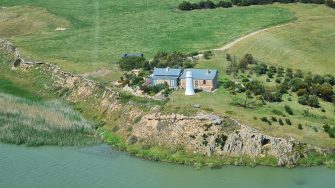
Date: Tuesday, October 27, 2020
Project: Eastern Australian Waterbird Survey
Observers: Richard Kingsford UNSW, John Porter UNSW/DPIE
Pilot: James Barkell NSW National Parks & Wildlife Service DPIE
It was cloudy this morning but at least not raining. So we headed straight for Wentworth, backtracking to survey the bit that we weren't able to do yesterday. As we got closer and closer to where the Darling meets the Murray at Wentworth, the rain was starting to come from the east. Luckily we turned west and headed down the Murray. This survey took us down the main channel of the river and then we hopped off to the side to survey the odd billabong along the way. There weren't many waterbirds on the river or the billabongs.
It's useful to divide the river into sections by using the different locks. We survey from Lock 10 to Lock three. These locks have changed the River Murray into a series of mini lakes, compared to the river it used to be.
Out on the Chowilla floodplain, there were some wetlands with water from environmental flows. Those that were shallow had hundreds of waterbirds including lots of swan with their broods, grey teal, hardhead, straw-necked Ibis, pelicans, Eurasian coots and pied stilts. There were also a few hundred red-necked avocets on one of the wetlands near the river.
The further west we went the brighter it got, important for our surveys. When we got to Beri on the River Murray we headed south, across the irrigated areas near the river on towards one of the salt evaporation ponds, marked with its dead trees. There were lots of swans, coot and teal here, presumably feeding on the seagrasses that grow in the salty water.
We caught up with the winding River Murray further south. Here it carves its way through the landscape, leaving high cliffs and a wide channel but relatively small floodplain.
And then onto Lake Alexandrina. This is an amazing body of water. It's almost sea-like. We worked our way across the northern sure of the Lake.
There were lots of great cormorants, pelicans, black swans, and colonies of straw-necked Ibis with one having a colony of pied cormorants.
We reached Goolwa to refuel and have lunch. Afterwards, we headed down to pick up the rest of Lake Alexandrina, surveying past the barrage and along the southern shoreline. There was the odd seal with a flipper pointed to the sky and the usual large numbers of waterbirds. There were more colonies of straw-necked ibis, pied cormorants and royal spoonbills. There were also hundreds of other waterbirds along the edge of the lake particularly cormorants, pelicans and Australian shelduck.
About halfway along the southern shoreline of Lake Alexandrina, we diverted south to Lake Albert. A quaint cottage sits on the clifftop overlooking the gap between the two lakes.
Lake Albert also had a colony of straw-necked ibis and hundreds of great cormorants, Australian shelduck, pelicans, whiskered terns and black swans. Surprisingly there weren't as many other waterbird species as in previous years, including few duck species. Perhaps some of them were on the Coorong – our survey tomorrow- or more likely they had gone north to the floods.
Blog by Richard Kingsford
